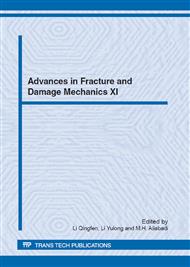p.385
p.389
p.393
p.397
p.401
p.405
p.409
p.413
p.417
Numerical Simulation of Hypervelocity Impact on Mesh Bumper Causing Fragmentation and Ejection
Abstract:
In order to study the fragmentation of projectile and ejection of debris clouds caused by hypervelocity impacting mesh bumper, simulation of aluminum sphere projectile hypervelocity normal impacting aluminum mesh bumper was practiced with SPH arithmetic of LS-DYNA soft. The diameter of projectile was 4mm. Impact velocities of aluminum spheres were varied between 2.2km/s and 6.2km/s. The impact angle was 0°. The relationship between the debris clouds characteristic of projectile and the impact position on aluminum mesh bumper was studied. The effect on fragmentation of projectile from different combination mode of aluminum mesh bumper was analyzed. The results showed that the morphologies of the debris cloud varied with the impact position when a projectile impacted the mesh bumper. The debris clouds as palpus was found, and some local kinetic energy concentrated appeared in the debris clouds. Debris clouds distribution was more uniform when projectile impacted wire across point on the mesh bumper. Debris clouds had more diffuse area and less residual kinetic energy when mesh bumper was combined with interleaving mode. Mesh bumper combined with interleaving mode was helpful in enhancing the protection performance of shields.
Info:
Periodical:
Pages:
401-404
Citation:
Online since:
November 2012
Authors:
Keywords:
Price:
Сopyright:
© 2013 Trans Tech Publications Ltd. All Rights Reserved
Share:
Citation:


